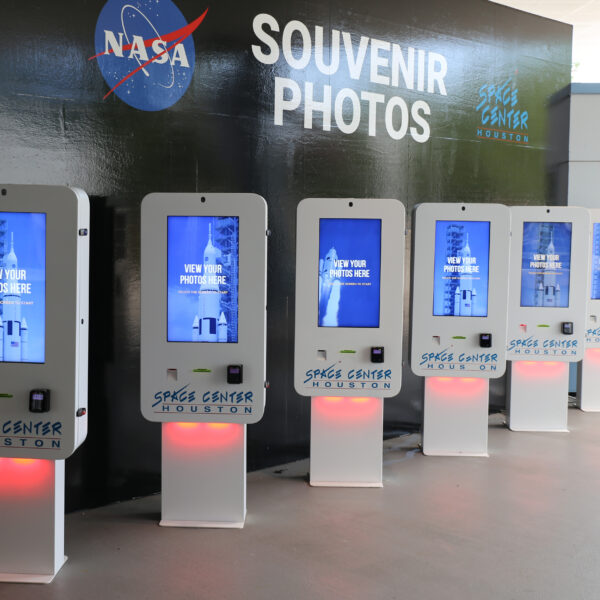
Kiosks
Close
Kiosk Industries


In-store displays can be made from a wide range of materials, each offering different characteristics and visual appeal. The choice of materials often depends on factors such as budget, durability, aesthetics, and the type of products being displayed.
Below, find common retail display materials.
Corrugated material is most often used for temporary or seasonal displays. Because of its versatility, this sturdy cardboard can be made into shelving, bins, stands, freestanding promotional signage, and more.
Corrugate is lightweight and easy to print on, making it suitable for temporary promotions and events, such as new product rollout, the back-to-school shopping season, holidays, and more.
This retail display material is also recyclable, making it an eco-friendly choice for temporary displays that have shorter lifecycles.
Metal, such as steel, aluminum, or iron, is commonly used to create sleek and sturdy permanent retail displays.
The metal parts are covered in powder coating, which helps to delay corrosion and adds to a display’s overall durability.
Metal displays offer a contemporary and industrial feel and are commonly used for electronics, gadgets, or fashion accessories.
Wire mesh displays are frequently used for hanging or showcasing products with hooks, making them suitable for products like hats, bags, or garments.
Along with its durability, an advantage to wire or mesh displays is its flexibility. Hooks and shelving can be moved around the wire or mesh to accommodate the display needs of different products, making it a versatile option.
Various types of plastics, such as PVC, polypropylene, and ABS, can be molded into different shapes to create custom displays. Plastic displays are sturdy and adaptable, perfect for various retail environments.
For temporary and semi-temporary displays, a lighter, thinner plastic can be used, since the display does not require an exceedingly long lifespan. However, for permanent displays, thicker and more durable types of plastic are necessary.
Acrylic is one such type of plastic. This polyacrylate, sometimes referred to as plexiglass, is a transparent material that can be used for creating modern and lightweight displays. This material is durable, affordable, and easy to manufacture into different shapes.
Acrylic is popular for showcasing smaller products like jewelry, cosmetics, or electronic devices. It can also be used for shelving, product card holders, book stands, and even pastry cases.
It’s also a great option for signage. Words, logos, images, etc. can be printed onto the backside of the plastic, which can give the print a nicely finished look.
While less popular, glass is harder to scratch than acrylic and provides a clean and sophisticated look. It is more delicate than acrylic, however, and while tempering glass makes it stronger, the process is rather costly, which is something to keep in mind.
Glass is most often used for high-end and elegant displays, particularly for luxury items like jewelry, watches, and high-end fashion. Visually versatile, it can complement modern or rustic displays.
Natural materials are often chosen because they match a particular aesthetic. This aesthetic usually leans towards more eco-friendly or rugged brands and products.
Some retail displays require natural accent materials like bamboo, rattan, or cork to create an organic feel, specifically targeting an audience of environmentally conscious customers.
Arguably the most used natural material is wood. Classic, sturdy, and multipurpose, it can be used in various types of retail displays. Most wood is used as a substructure, but sometimes wood is chosen because it matches a brand’s identity.
It can be stained, painted, or left natural to create a rustic or modern look. Wood displays are suitable for a wide range of products and can be custom-built to fit specific needs or esthetics.
Sometimes all-natural isn’t a feasible option, and a brand might choose to go with a composite material for their display.
The most common composite material is called MDF, which stands for Medium-Density Fiberboard. While not quite as strong as wood, MDF is a cost-effective material that is often used as a substitute for solid wood in retail displays.
In general, MDF can be used when wood is called for but not in the budget. A wood veneer can be applied as a laminate to the MDF if the wood grain look is desired, allowing it to blend in with its natural counterpart.
Fabric displays refer to a banner or fabric tension display. Banners, being so light in weight, are often used for display toppers in lieu of heavier, more traditional print signage.
For tension displays, fabric is pulled taut over a solid frame to create an advertisement. Because pliable fabric is generally used for these displays, the signage created by the fabric will follow the shape of the frame underneath.
Fabric displays can be easily customized with different patterns and graphics to match a brand's aesthetic and are commonly used to merchandise clothing, accessories, or textiles.
Depending on a display’s purpose, intended lifespan, brand aesthetic, and more, the materials used to build a retail display should be chosen with care.
Every material has its own unique offerings, and understanding the pros and cons of each is critical when looking to create an effective and visually appealing presentation.